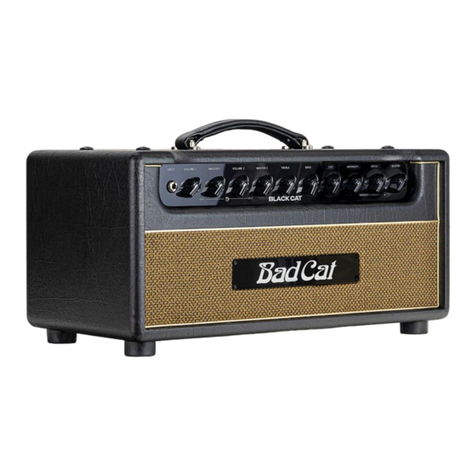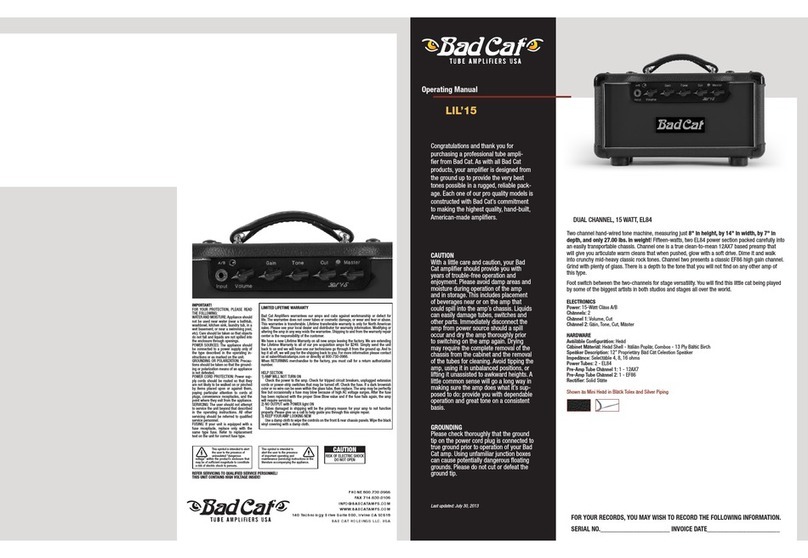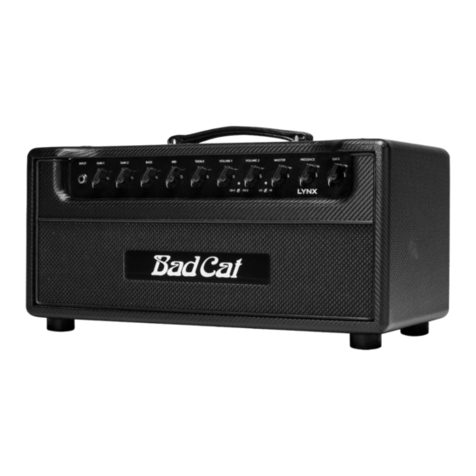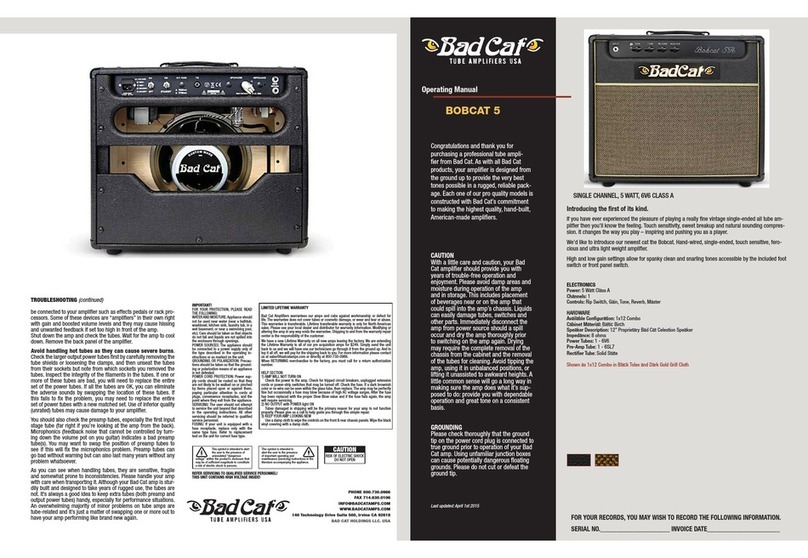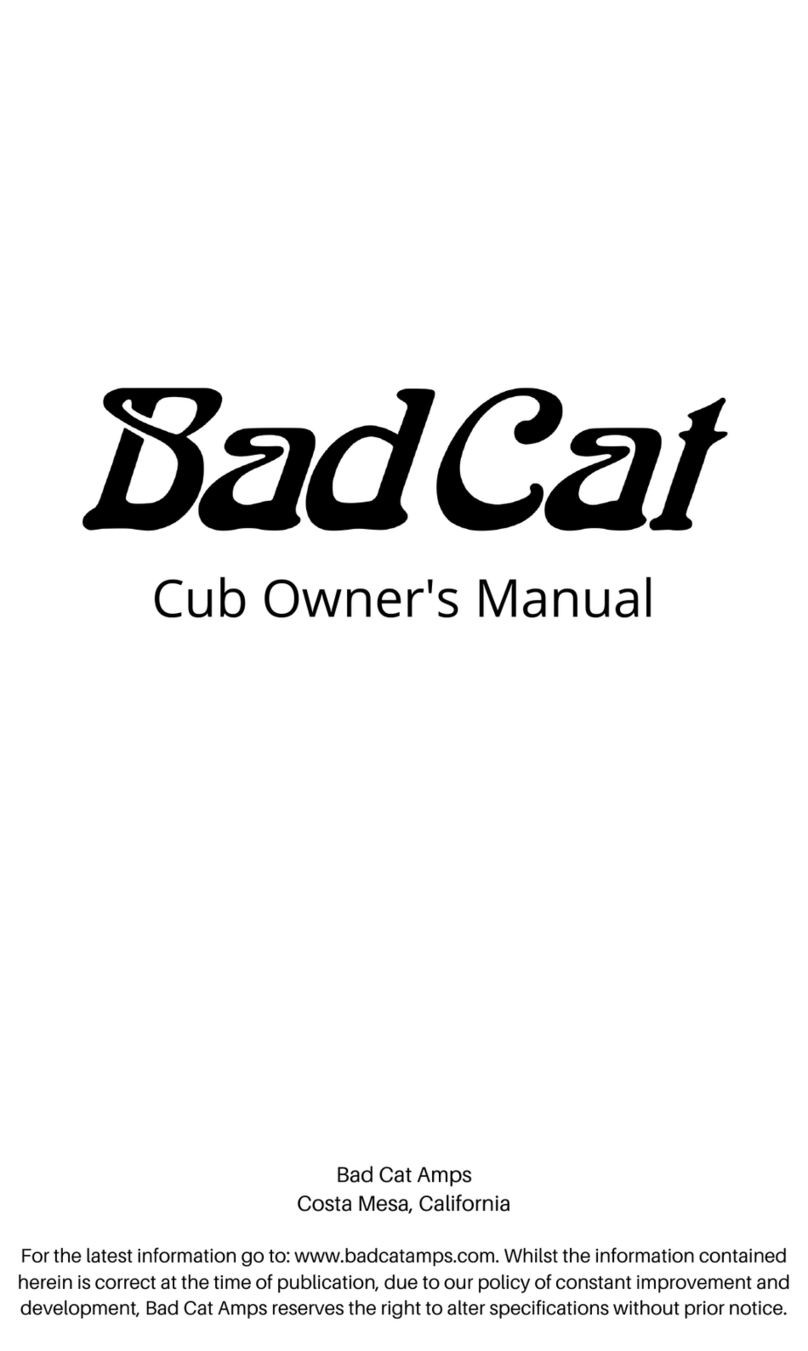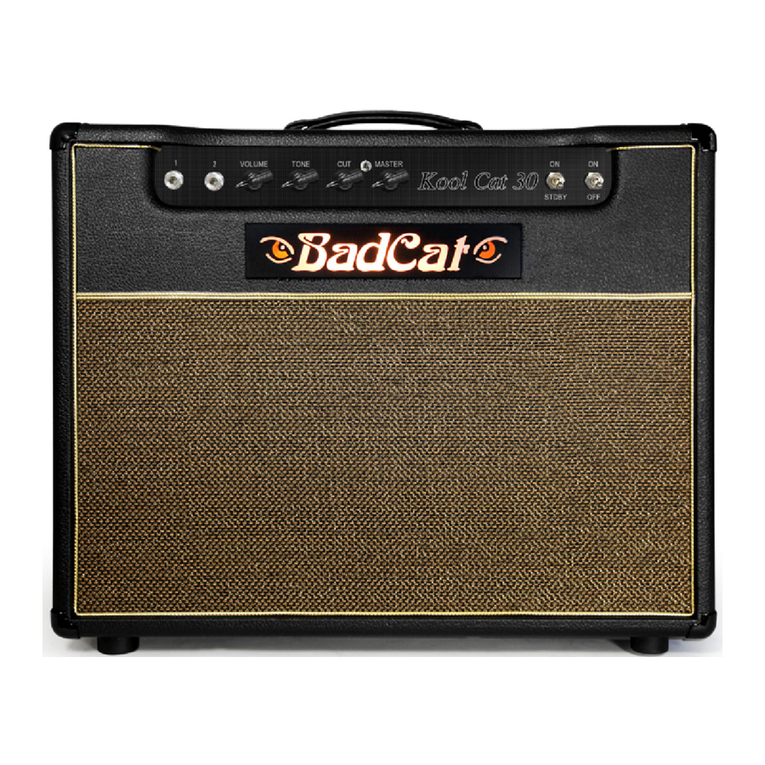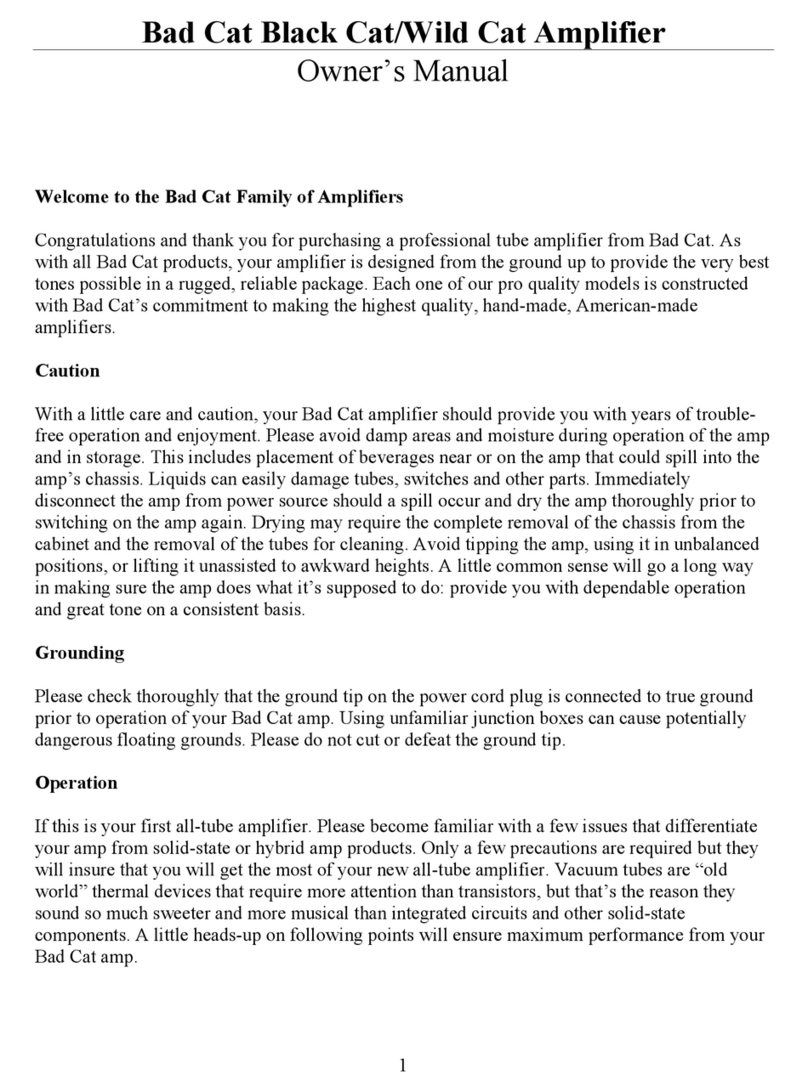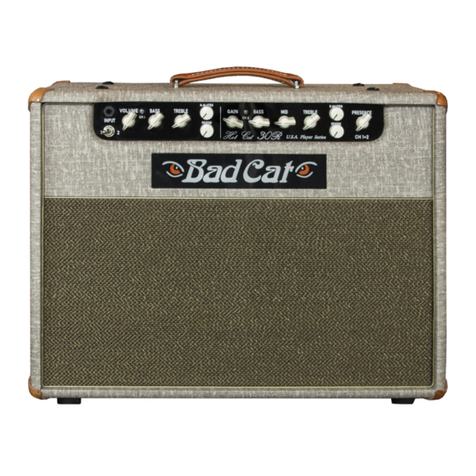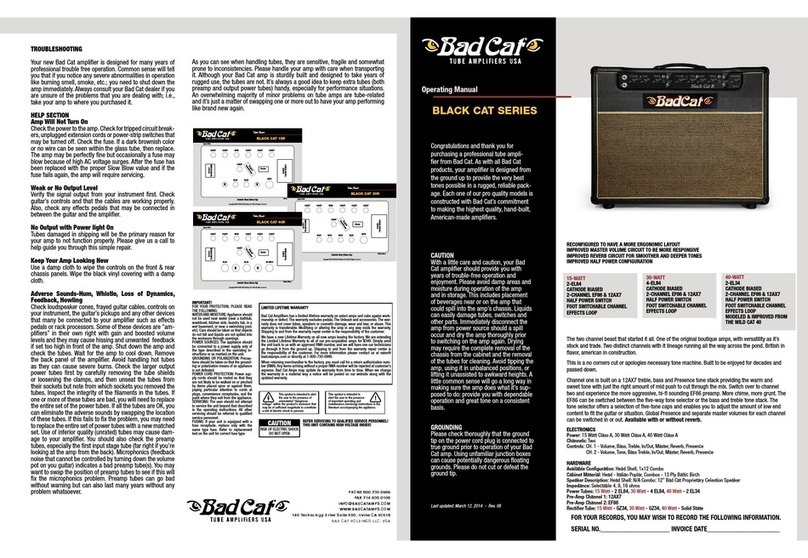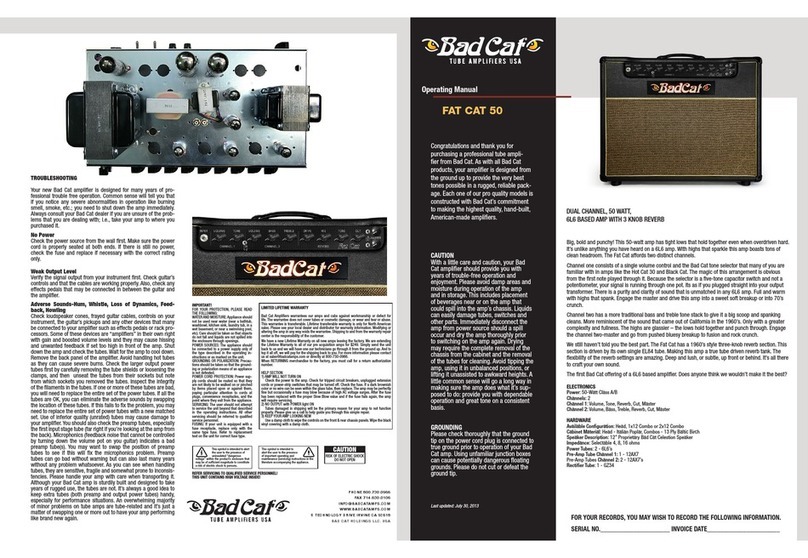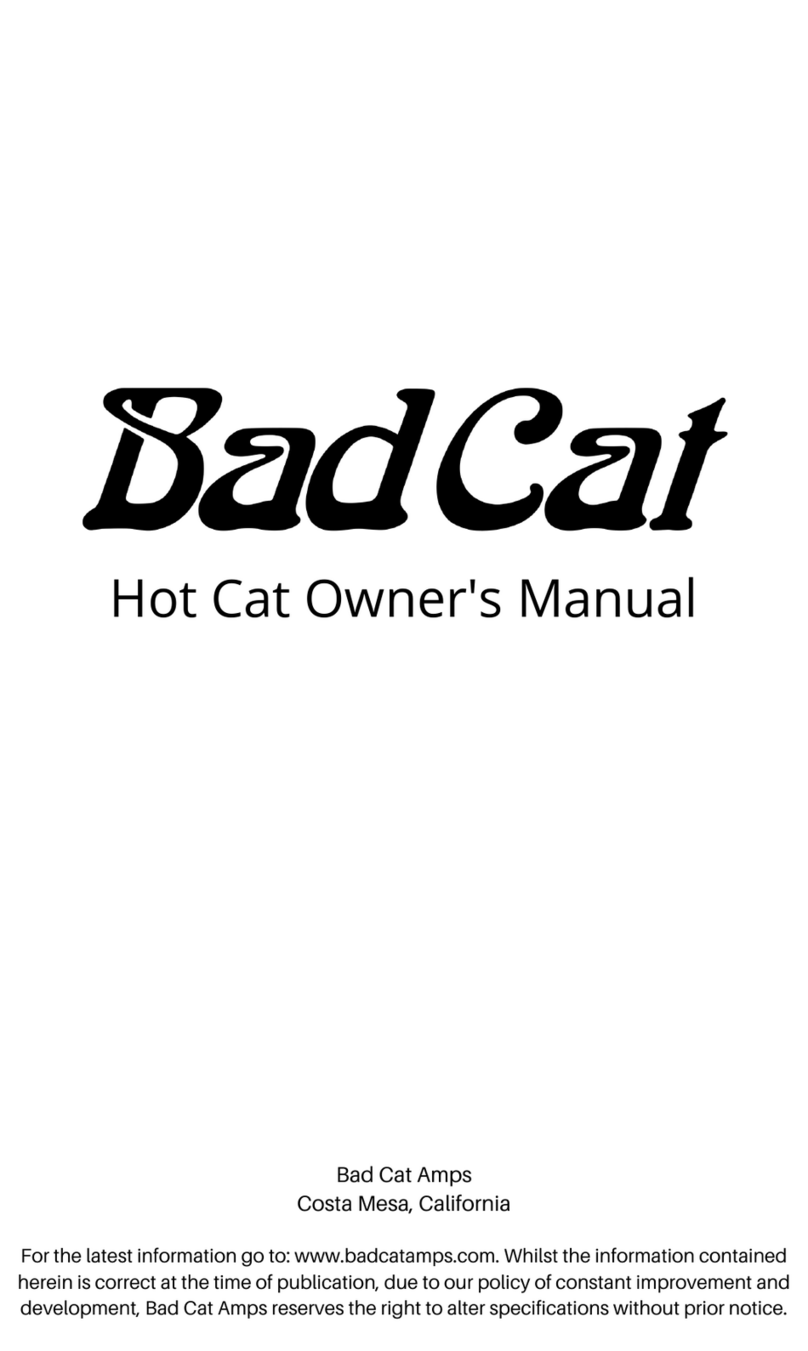Congratulations and thank you for
purchasing a professional tube ampli-
er from Bad Cat. As with all Bad Cat
products, your amplier is designed from
the ground up to provide the very best
tones possible in a rugged, reliable pack-
age. Each one of our pro quality models is
constructed with Bad Cat’s commitment
to making the highest quality, hand-built,
American-made ampliers.
CAUTION
With a little care and caution, your Bad
Cat amplier should provide you with
years of trouble-free operation and
enjoyment. Please avoid damp areas and
moisture during operation of the amp
and in storage. This includes placement
of beverages near or on the amp that
could spill into the amp’s chassis. Liquids
can easily damage tubes, switches and
other parts. Immediately disconnect the
amp from power source should a spill
occur and dry the amp thoroughly prior
to switching on the amp again. Drying
may require the complete removal of the
chassis from the cabinet and the removal
of the tubes for cleaning. Avoid tipping the
amp, using it in unbalanced positions, or
lifting it unassisted to awkward heights. A
little common sense will go a long way in
making sure the amp does what it’s sup-
posed to do: provide you with dependable
operation and great tone on a consistent
basis.
GROUNDING
Please check thoroughly that the ground
tip on the power cord plug is connected to
true ground prior to operation of your Bad
Cat amp. Using unfamiliar junction boxes
can cause potentially dangerous oating
grounds. Please do not cut or defeat the
ground tip.
FOR YOUR RECORDS, YOU MAY WISH TO RECORD THE FOLLOWING INFORMATION.
SERIAL NO._____________________ INVOICE DATE______________________
Last updated: July 30, 2013
LIMITED LIFETIME WARRANTY
Bad Cat Ampliers warrantees our amps and cabs against workmanship or defect for
life. The warrantee does not cover tubes or cosmetic damage, or wear and tear or abuse.
This warrantee is transferable. Lifetime transferable warranty is only for North American
sales. Please see your local dealer and distributor for warranty information. Modifying or
altering the amp in any way voids the warrantee. Shipping to and from the warranty repair
center is the responsibility of the customer.
We have a new Lifetime Warranty on all new amps leaving the factory. We are extending
the Lifetime Warranty to all of our pre acquisition amps for $249. Simply send the unit
back to us and we will have one our technicians go through it from the ground up. And to
top it all off, we will pay for the shipping back to you. For more information please contact
us at sales@badcatamps.com or directly at 800-730-0966.
When RETURNING merchandise to the factory, you must call for a return authorization
number.
HELP SECTION
1) AMP WILL NOT TURN ON
Check the power to the amp. Check for tripped circuit breakers, unplugged extension
cords or power-strip switches that may be turned off. Check the fuse. If a dark brownish
color or no wire can be seen within the glass tube, then replace.The amp may be perfectly
ne but occasionally a fuse may blow because of high AC voltage surges. After the fuse
has been replaced with the proper Slow Blow value and if the fuse fails again, the amp
will require servicing.
2) NO OUTPUT with POWER light ON
Tubes damaged in shipping will be the primary reason for your amp to not function
properly. Please give us a call to help guide you through this simple repair.
3) KEEP YOUR AMP LOOKING NEW
Use a damp cloth to wipe the controls on the front & rear chassis panels. Wipe the black
vinyl covering with a damp cloth.
IMPORTANT!
FOR YOUR PROTECTION, PLEASE READ
THE FOLLOWING:
WATER AND MOISTURE: Appliance should
not be used near water (near a bathtub,
washbowl, kitchen sink, laundry tub, in a
wet basement, or near a swimming pool,
etc). Care should be taken so that objects
do not fall and liquids are not spilled into
the enclosure through openings.
POWER SOURCES: The appliance should
be connected to a power supply only of
the type described in the operating in-
structions or as marked on the unit.
GROUNDING OR POLARIZATION: Precau-
tions should be taken so that the ground-
ing or polarization means of an appliance
is not defeated.
POWER CORD PROTECTION: Power sup-
ply cords should be routed so that they
are not likely to be walked on or pinched
by items placed upon or against them,
paying particular attention to cords at
plugs, convenience receptacles, and the
point where they exit from the appliance.
SERVICING: The user should not attempt
to service the unit beyond that described
in the operating instructions. All other
servicing should be referred to qualied
service personnel.
FUSING: If your unit is equipped with a
fuse receptacle, replace only with the
same type fuse. Refer to replacement
text on the unit for correct fuse type.
This symbol is intended to alert
the user to the presence of
uninsulated “dangerous
voltage” within the product’s enclosure that
may be of sufcient magnitude to constitute
a risk of electric shock to persons.
This symbol is intended to
alert the user to the presence
of important operating and
maintenance (servicing) instructions in the
literature accompanying the appliance.
CAUTION
RISK OF ELECTRIC SHOCK
DO NOT OPEN
REFER SERVICING TO QUALIFIED SERVICE PERSONNEL!
THIS UNIT CONTAINS HIGH VOLTAGE INSIDE!
PHONE 800.730.0966
FAX 714.630.0106
INFO@BADCATAMPS.COM
WWW.BADCATAMPS.COM
140 Technology Drive Suite 500, Irvine CA 92618
BAD CAT HOLDINGS LLC. USA
Operating Manual
TREM CAT 30
SINGLE CHANNEL, 30 WATT, EL84
Start with the rich chime of the EF86 side of a Black Cat 30. Add lush reverb and pulsating tremolo
and you have one of the nest single channel amps ever made. A 4 - EL84 30 watt power platform
running in Class A provides the engine. The Trem Cat is a Guitar Player magazine Editors’ Award
winner and perhaps our most versatile single channel amp.
The tone circuit is truly unique and affords unparalleled control over your tone shaping. There are
two basic tonal options available. First, our ve
position tone cap selector and our standard bass and treble tone stack. The selector switch is the
key to dialing in your sound. Position one bypasses the tone stack altogether and feels like you are
plugged strait into your output section. Position two activates the ve way tone selector. Allowing
you ve choices of tone caps and affording great control over the bottom end and thickness. Posi-
tion three moves you over to the bass and treble controls.
Here the amp has more of a scooped hi- type of feel. Lastly, position four engages both the selec-
tor and the bass and treble controls.
Between the cut control which adds high end sparkle, near innite tone shaping can be had here.
A master volume that can be switched out of the circuit along with a half power
switch insures that you can get to any level of gain at just about any volume level.
ELECTRONICS
Power: 30/15-Watt Class A
Channels: 1
Controls: Volume, Tone, Select, Bass, Treble, Speed, Depth, Reverb, Cut, Master
HARDWARE
Available Conguration: Head, 1x12 Combo or 2x12 Combo
Cabinet Material: Head - Italian Poplar, Combos - 13 Ply Baltic Birch
Speaker Description: 12” Proprietary Bad Cat Celestion Speaker
Impedance: Selectable 4, 8, 16 ohms
Power Tubes: 4 - EL84’s
Pre-Amp Tubes: 1 - EF86, 4 - 12AX7’s
Rectier Tube: 1 - GZ34
Speaker Out
This jack is adding an extension speaker cabinet to be
used with the internal speaker of the Tone Cat. The internal
speaker runs at 8 ohms for a single 12 or 4 ohms for a 2x12
and is parallel with the extension speaker jack.
Speaker Impedance
On a combo this rotary selector knob comes set at 8 ohms
for a single 12 or 4 ohms for a 2x12. The selector knob can
select between 4, 8 and 16 ohms. Check Ohm’s Law if us-
ing an additional extension cabinet to select the right ohm
setting. Example: 8 ohms + 8 ohms = 4 ohm setting.
On a head, please be sure to select the proper ohms to
match your cabinet.
Speaker Phase Switch
This switch changes the phase of your amp’s speakers.
When the amp is played by itself, either position will sound
good, but slightly different. Here is another case where a
little experimentation is worthwhile to nd what is right for
you. This switch becomes very important, though, when the
amp is used in conjunction with another amp in a dual amp
setup. If the speaker in the two amps are set “out of phase”
with each other your tone could be weakened considerably.
So when you’re running the amp simultaneously with an-
other amp, be sure to check this switch to see if one posi-
tion or the other is giving you a better result.
TROUBLESHOOTING
Your new Bad Cat amplier is designed for many years of
professional trouble free operation. Common sense will tell
you that if you notice any severe abnormalities in operation
like burning smell, smoke, etc.; you need to shut down the
amp immediately. Always consult your Bad Cat dealer if you
are unsure of the problems that you are dealing with; i.e.,
take your amp to where you purchased it.
No Power
ICheck the power source from the wall rst. Make sure the
power cord is properly seated at both ends. If there is still
no power, check the fuse and replace if necessary with the
correct rating only.
Weak Output Level
Verify the signal output from your instrument rst. Check
guitar’s controls and that the cables are working properly.
Also, check any effects pedals that may be connected in
between the guitar and the amplier.
Adverse Sounds-Hum, Whistle, Loss of Dynamics,
Feedback, Howling
Check loudspeaker cones, frayed guitar cables, controls on
your instrument, the guitar’s pickups and any other devices
that many be connected to your amplier such as effects
pedals or rack processors. Some of these devices are “am-
pliers” in their own right with gain and boosted volume
levels and they may cause hissing and unwanted feedback
if set too high in front of the amp. Shut down the amp and
check the tubes. Wait for the amp to cool down. Remove
the back panel of the amplier. Avoid handling hot tubes
as they can cause severe burns. Check the larger output
power tubes rst by carefully removing the tube shields
or loosening the clamps, and then unseat the tubes from
their sockets but note from which sockets you removed the
tubes. Inspect the integrity of the laments in the tubes. If
one or more of these tubes are bad, you will need to replace
the entire set of the power tubes. If all the tubes are OK, you
can eliminate the adverse sounds by swapping the location
of these tubes. If this fails to x the problem, you may need
to replace the entire set of power tubes with a new matched
set. Use of inferior quality (unrated) tubes may cause dam-
age to your amplier. You should also check the preamp
tubes, especially the rst input stage tube
(far right if you’re looking at the amp from the back). Microphonics (feedback
noise that cannot be controlled by turning down the volume pot on you guitar)
indicates a bad preamp tube(s). You may want to swap the position of preamp
tubes to see if this will x the microphonics problem. Preamp tubes can go bad
without warning but can also last many years without any problem whatsoever.
As you can see when handling tubes, they are sensitive, fragile and somewhat
prone to inconsistencies. Please handle your amp with care when transporting
it. Although your Bad Cat amp is sturdily built and designed to take years of
rugged use, the tubes are not. It’s always a good idea to keep extra tubes (both
preamp and output power tubes) handy, especially for performance situations.
An overwhelming majority of minor problems on tube amps are tube-related
and it’s just a matter of swapping one or more out to have your amp performing
like brand new again.
